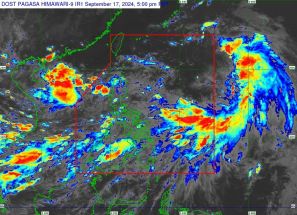Inflation

Inflation, according to Investopedia.com, is the decline of purchasing power of a given currency over time. For us, this means the peso effectively buys less than it did in prior periods.
The Philippines’ inflation rate rose to 5.4 percent in May, higher than the 4.9 percent recorded last April. The government’s economic team has estimated that average inflation for the entire 2022 would be in the 3.7 percent to 4.7 percent range, an upward revision from their previous forecast.
We have our structural problems with energy and food pushing up inflation that were aggravated by Russia’s invasion of Ukraine. High oil prices and a Russian blockade that prevented the delivery of Ukraine’s wheat to world markets caused higher than usual inflation.
Transport inflation in May greatly contributed to total inflation, as gasoline and diesel inflation shot up to 47.2 percent and 86.2 percent, respectively.
But inflation in Metro Manila was lower than the national average at 4.7 percent, while inflation outside the capital region was at 5.5 percent. The Cordillera Administrative Region has the highest inflation rate, 6.9 percent.
With diesel and gasoline prices approaching P100/liter and with the bakers asking for a price increase for pandesal and tasty sliced bread, a serious social problem will greet the new administration.
“I am concerned,” Rep. Joey Salceda said, “that the poor are getting hit harder than everyone else in this. The inflation rate for the bottom 30 percent of households, year to date, has been 4.3 percent, whereas general inflation has been 3.5 percent year to date.”
The economist-congressman continued: “As I warned earlier this year, flour-based products are also beginning to pick up in price. That, too, will persist due to world supply constraints on wheat.”
“The immediate impact inflation will have on the poorest households will be in nutrition. As face-to-face classes resume, we also have to aggressively implement the nationwide feeding program required by law, to supplement food intake among children from low-income households.
“I emphasize that inflation has been faster in 14 regions outside of NCR. Price increases are affecting provinces harder than NCR.”
Salceda sees “measures to subsidize sectors with second round effects, such as public transport and agriculture, will be vital. We must also produce more food at affordable prices.”
For now, all the government can do is to expedite release of any subsidies still undistributed. There is still Duterte’s promised ayuda of P500 monthly, a measure offered in lieu of suspending fuel excise taxes. That, of course, will hardly ease hunger at the bottom of society.
Perhaps, this is why Junior is taking time to carefully select the next Secretaries of Agriculture, Transportation and Energy. These nominees will have to be undoubtedly competent. They are the officials who will lead programs on the ground. The economic managers can only work on the policy and finance sides.
Food security will be the most important concern. Many countries are now restricting the export of wheat, rice and other commodities. In our region, Thailand is trying to create a rice cartel with Vietnam.
The next agriculture secretary will have to be more market savvy than academic in inclination and experience. Supply problems in food increase inflationary pressures. Other than the cereals, we have existing supply problems in fish, some vegetables, pork, beef and chicken.
While it is good to roll out programs with long-term promise, the problem is now. Still, we need to change strategies in growing rice, our staple food.
The outgoing agriculture reform secretary is saying it is possible to increase production to bring the price of rice to P20/kg if we consolidate small farm lots into mega-farms for rice production. This means dumping our current agrarian reform concept, something we should have done ages ago.
The agrarian reform secretary described the mega farm as a cluster of contiguous farms that are consolidated to form a sizable plantation capable of producing large volumes. The idea is to have a mega farm with a production core or area of at least 50 hectares of contiguous agrarian reform lands.
The proposal is to provide infrastructure to support production, postharvest, processing and marketing, including farm-to-market roads and bridges, irrigation, potable water supply, warehouses and storage facilities, greenhouses, and inputs and product distribution stations.
Agrarian reform beneficiaries may choose to work with a local or foreign investor-led production core, joint venture or lease agreement or management contract.
The proposal is to start with 150,000 hectares of rice land, fully mechanized, under the coverage of the Comprehensive Agrarian Reform Program.
Now that the proposal is coming from the agrarian reform secretary, it makes sense to combine the two departments for best results. The DA can do little with the restrictions of CARP. And the agrarian reform department needs DA’s technical expertise and experience.
But what can we do for the meantime? The first few months will probably require the new agriculture secretary or trade and industry secretary or both to travel the world to sign up food supply agreements. That was what the late energy secretary Ronnie Velasco did in his first months in office to assure our oil supply contracts.
The problem now with oil is not supply availability unlike in the early 80s. The problem is atrociously high prices. The only way to keep our transport sector moving is a dramatic shift to EVs. Junior can test his supposed friendship with China, the world’s largest producer of EVs, by asking for assistance in supplying EVs.
According to Statista.com, China is projected to produce around 13 million battery electric vehicles (BEV) and plug-in hybrid electric vehicles (PHEV) by 2023, more than any other nation worldwide. China’s estimated production level is also anticipated to exceed the combined output of other large markets, including the United States, Germany, and Japan.
Going EV now for public transport, following the Aboitiz Power experiment in Davao, is one way of alleviating a crisis in public transportation as diesel prices go beyond what jeepney drivers can afford.
Such punishing headaches for the new administration. Junior may soon wish Antman didn’t convince him to seek the presidency.
Boo Chanco’s email address is [email protected]. Follow him on Twitter @boochanco
- Latest
- Trending































